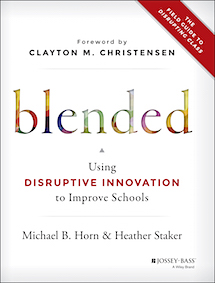A Field Guide to Blended Learning
Blended: Using Disruptive Innovation to Improve Schools
By Michael B. Horn and Heather Staker
(Jossey-Bass, 2014 – Learn more)

In this follow-up to Disrupting Class, Michael B. Horn and Heather Staker provide a field guide to understanding and implementing blended learning in classrooms and schools. The authors define blended learning in three parts (34-35):
– Any formal education program in which a student learns at least in part through online learning, with some element of student control over time, place, path, and/or pace.
– The students learns at least in part in a supervised brick-and-mortar location away from home.
– The modalities along each student’s learning path within a course or subject are connected to provide an integrated learning experience.
This definition was developed after conducting interviews with educators involved in over 150 blended-learning programs. It is “broad enough to allow for variation but narrow enough to differentiate it from the bottomless category of the use of edtech in schools”(34).
Organization of the book

At the end of each chapter, the authors provide a list of endnotes that either cite the source of their information, or dig deeper into a specific topic. Also peppered throughout the text are graphics and visuals that depict school schedules, learning frameworks, and the differences between blended learning and the more traditional model of school.
What I liked
There are several reasons to have this book on your shelf. First of all, the authors know their stuff. Horn and Staker have a clear understanding of not only blended learning, but also the necessary steps to take for school change, as well as proven strategies to help educators achieve their goals.
Second, the authors do not lead with digital tools. Throughout the text, they make it clear that strong pedagogy, such as personalized learning, always trumps technology. “When schools cram computers into traditional classrooms, at best they sustain or only slightly improve the way they already teach and run the schools”(79).
A third positive about the book is the sense of urgency Horn and Staker create in their push to see blended learning implemented in schools. One of the most obvious needs for blended learning is in areas where there is no local access to particular courses or content. The authors define this situation as “nonconsumption opportunities.”
In one case, high schools in Miami could not hire highly qualified teachers to facilitate essential courses for college and career readiness. This led to the creation of the Florida Virtual School. Currently, FVS provides access to coursework for as many as 10,000 students in more than 56 brick-and-mortar schools. The need for blended learning in these types of circumstances is hard to refute.
What I didn’t like
The first and most obvious knock on Blended for me was the corporate influence that pervades the text. For example, Horn and Staker repeatedly reference the KIPP charter school system as a model for blended learning. If you go to KIPP’s website, you can easily discover that KIPP’s biggest funder is The Walton Foundation (Walmart), to the tune of $50 million. Knowing the Walton Foundation’s affinity for vouchers in the name of privatizing public education, it was hard for this public school educator to keep a balanced perspective as I read the text.
Second, the references that the authors frequently cite often fall into one of two categories: 1) Their own work, or 2) Studies conducted by the very charter school organizations being referenced in the text. Very few citations actually lead to any independent studies that would take an unbiased look at the effectiveness of blended learning. There is other evidence to validate this teaching method. A quick preview of respected journals such as Reading Research Quarterly or Phi Delta Kappan would reveal several studies that would support this initiative.
Third, and this connects back to the first reason, the videos depicting blended learning in action feel more like commercials than an authentic representation of powerful learning in action. It was like Horn and Staker wanted to sell me on blended learning and the organizations that support it, instead of letting readers see for themselves. When we make a case for anything, including the counter argument is critical.
In summary
So the question remains: Should I or should I not buy this book? I think it depends on your setting and situation. If you are currently a part of a blended learning initiative, this book has many strategies and success stories that would serve well for school leaders looking to make this shift. However, if one is just exploring the concept, I think it would be wise to pass. Its heavy corporate influence and the lack of citing reliable evidence to support blended learning leaves the reader with more questions than answers.
Matt Renwick is a 16-year public educator who began as a 5th and 6th grade teacher in a country school outside of Wisconsin Rapids, WI. After seven years of teaching, he served as a junior high dean of students, assistant principal and athletic director before becoming an elementary school leader in Wisconsin Rapids. Matt blogs at Reading by Example, tweets @ReadByExample and also writes for EdTech magazine and other publications. His book Digital Student Portfolios: A Whole School Approach to Connected Learning and Continuous Improvement was published in July 2014.






























